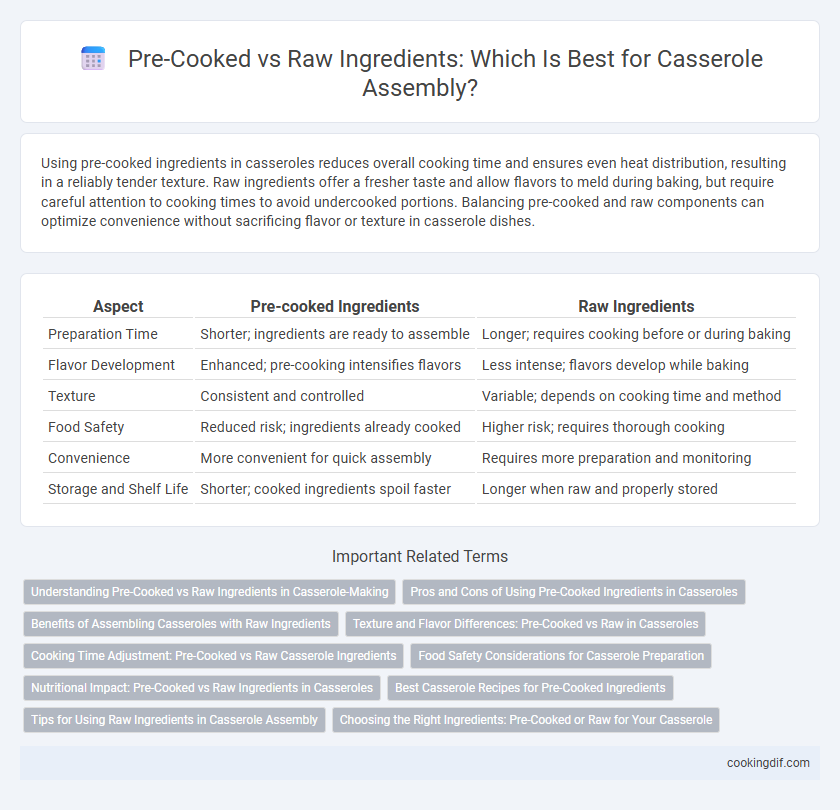Using pre-cooked ingredients in casseroles reduces overall cooking time and ensures even heat distribution, resulting in a reliably tender texture. Raw ingredients offer a fresher taste and allow flavors to meld during baking, but require careful attention to cooking times to avoid undercooked portions. Balancing pre-cooked and raw components can optimize convenience without sacrificing flavor or texture in casserole dishes.
Table of Comparison
| Aspect | Pre-cooked Ingredients | Raw Ingredients |
|---|---|---|
| Preparation Time | Shorter; ingredients are ready to assemble | Longer; requires cooking before or during baking |
| Flavor Development | Enhanced; pre-cooking intensifies flavors | Less intense; flavors develop while baking |
| Texture | Consistent and controlled | Variable; depends on cooking time and method |
| Food Safety | Reduced risk; ingredients already cooked | Higher risk; requires thorough cooking |
| Convenience | More convenient for quick assembly | Requires more preparation and monitoring |
| Storage and Shelf Life | Shorter; cooked ingredients spoil faster | Longer when raw and properly stored |
Understanding Pre-Cooked vs Raw Ingredients in Casserole-Making
Pre-cooked ingredients in casserole assembly reduce overall baking time and ensure even heat distribution, preventing undercooked portions, while raw ingredients require longer cooking to achieve tenderness and flavor integration. Selecting pre-cooked components like roasted vegetables or cooked meats optimizes texture and consistency, whereas raw ingredients offer fresher taste but demand precise timing to avoid sogginess or dryness. Balancing these options in casserole-making enhances convenience and flavor depth, tailored to recipe complexity and desired meal preparation speed.
Pros and Cons of Using Pre-Cooked Ingredients in Casseroles
Using pre-cooked ingredients in casseroles significantly reduces overall cooking time, allowing for quicker meal preparation and convenience. This method ensures even cooking and minimizes the risk of undercooked components, but it may result in less depth of flavor compared to slow-cooked raw ingredients. However, pre-cooked ingredients can sometimes lead to a soggier texture if moisture is not properly drained or balanced during assembly.
Benefits of Assembling Casseroles with Raw Ingredients
Assembling casseroles with raw ingredients preserves the freshness and natural flavors of each component, enhancing the overall taste and texture of the dish. Raw vegetables and meats retain more nutrients during the baking process, offering a healthier meal option compared to pre-cooked ingredients that can lose moisture and nutrients. This approach also simplifies preparation by reducing initial cooking time and allows flavors to develop fully as the ingredients cook together in the casserole.
Texture and Flavor Differences: Pre-Cooked vs Raw in Casseroles
Using pre-cooked ingredients in casseroles enhances flavor depth by allowing spices and seasonings to fully develop before baking, resulting in a richer taste profile. Raw ingredients, on the other hand, offer a fresher texture but may release excess moisture during cooking, potentially leading to a softer or less distinct texture. Texture contrast is more pronounced with pre-cooked components, as they retain firmness and create layered mouthfeel compared to the uniform softness of raw-only casseroles.
Cooking Time Adjustment: Pre-Cooked vs Raw Casserole Ingredients
Pre-cooked casserole ingredients significantly reduce overall cooking time, allowing the casserole to heat through and meld flavors efficiently without overcooking. Raw ingredients require longer baking to ensure thorough cooking, particularly for dense vegetables and meats, necessitating careful adjustment to prevent undercooked centers or burnt edges. Balancing pre-cooked and raw components involves modifying oven temperature and bake duration to achieve optimal texture and flavor integration.
Food Safety Considerations for Casserole Preparation
Using pre-cooked ingredients in casserole assembly reduces the risk of foodborne illnesses by ensuring all components reach safe internal temperatures more evenly during baking. Raw ingredients require careful handling and longer cooking times to eliminate pathogens such as Salmonella and Listeria, making it crucial to follow precise temperature guidelines (165degF or 74degC) for safe consumption. Proper layering and thorough mixing of ingredients promote even heat distribution, minimizing the potential for undercooked areas and enhancing overall food safety.
Nutritional Impact: Pre-Cooked vs Raw Ingredients in Casseroles
Using pre-cooked ingredients in casseroles can reduce cooking time but may lead to nutrient loss, especially in water-soluble vitamins like vitamin C and B-complex. Raw ingredients retain more nutrients when cooked together, as shorter exposure to heat preserves antioxidants and minerals. Balancing raw and pre-cooked components optimizes texture and nutritional value while ensuring thorough cooking and food safety.
Best Casserole Recipes for Pre-Cooked Ingredients
Pre-cooked ingredients enhance casserole assembly by reducing overall cooking time and ensuring even heat distribution, making dishes like chicken and rice or beef and vegetable casseroles tender and flavorful. Best casserole recipes for pre-cooked ingredients often feature a creamy base, such as condensed soup or a cheese sauce, which melds flavors and maintains moisture during baking. Using pre-cooked meats, grains, and vegetables optimizes texture and allows for quick weeknight meals without sacrificing taste or quality.
Tips for Using Raw Ingredients in Casserole Assembly
Using raw ingredients in casserole assembly ensures a fresher flavor and retains more nutrients compared to pre-cooked components. To prevent uneven cooking, cut vegetables into uniform sizes and layer ingredients strategically, placing items with longer cooking times at the bottom. Incorporate moisture-rich elements like sauces or broths to promote tenderness and avoid dryness during baking.
Choosing the Right Ingredients: Pre-Cooked or Raw for Your Casserole
Choosing between pre-cooked and raw ingredients for casserole assembly significantly impacts cooking time and texture. Pre-cooked ingredients like chicken, beans, and vegetables reduce overall baking time and ensure even cooking, while raw ingredients can deepen flavors but require longer cooking to reach the desired tenderness. Selecting the right option depends on convenience preferences and the desired balance between flavor development and preparation speed.
Pre-cooked vs Raw Ingredients for casserole assembly Infographic

 cookingdif.com
cookingdif.com